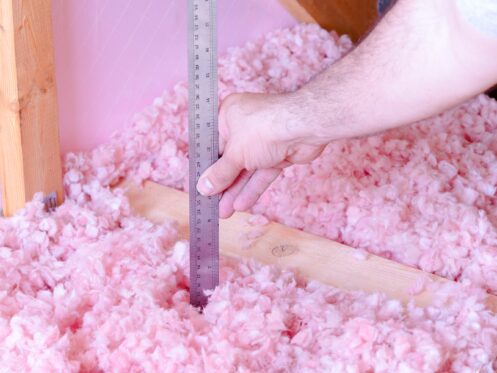You already know Florida summers may feel like you’re walking into a steam room, but what you might not realize is how much your home’s insulation affects your comfort. If you’ve got cool air leaking out or muggy heat sneaking in, your air conditioner is running a marathon just to keep up.
At Plumbing, Cooling & Electrical Nerds, located in Cape Coral, FL, we help homeowners identify the areas that are overworking their cooling systems. A lack of regular AC maintenance is a big one we encounter, but it’s also common for homes to lose AC efficiency due to poor insulation.
Read this guide to learn why that is and what you can do to fix it!
Heat Creeps Through Your Attic When Insulation Is Poor
When your attic lacks thick insulation, it lets Florida’s hot air slip into your living space like water through a leaky boat. The hot attic warmth accumulates over the rooms below, warming them even after the sun sets. You might crank up the AC, but you’ll still feel the extra warmth in the upper rooms.
Dense insulation in the attic helps block some of that heat transfer, so your air conditioner isn’t adversely affected by a hot attic. You’ll feel more comfortable when insulation traps heat where it belongs, outside of the living spaces. With proper attic insulation, your AC system doesn’t have to work as hard.
Walls Work Harder When Insulation is Missing or Thin
Your home’s exterior acts like skin, and insulation adds protective fat. When wall cavities are empty or underfilled, walls become thermal highways for Florida’s warm, moist air. Heat presses against the plaster and pushes toward the cooler inside. That forces your AC to counteract both outdoor heat and the warmth inside the walls. Wall insulation forms a barrier that helps to keep the rooms cool.
Windows Let Sunlight Turn Into AC Workload
Single-pane windows and frames that lack weatherstripping allow the sun’s radiant heat to enter your home, causing the AC to work harder to maintain the set temperature. Even with curtains closed, the glass still warms and radiates heat energy into the room. High-quality window insulation options, such as double-pane units, low-E coatings, and thermal blinds, help reduce the sun’s heat.
They lighten the load on your AC during peak hours. If your current windows are warm to the touch on summer mornings, that heat is being transferred indoors. If you upgrade your windows, you can reduce peak cooling demand, which in turn lowers both energy use and system strain.
Doors Share Heat if They Lack Insulation
Uninsulated doors make entrances into the home feel like a furnace. Hollow-core doors retain heat like a sponge, allowing it to escape into your hallway and living areas. That forces the cooling system to ramp up. That heat finds its way in through gaps around the frame and under the bottom of the door.
Weatherstripping stops drafts, but a solid core or insulated metal entry door keeps heat away entirely. That keeps cooled spaces more stable and reduces the amount of heat that would otherwise be affecting your AC. Even a sealed door with reflective surface material improves the speed at which your space recovers after someone enters or exits, especially around your cooling thermostat.
Insulated Ductwork Keeps Air Cooler
Your ductwork shapes the path for cold air, but if it travels through uninsulated attics or crawlspaces, it can absorb heat along the way. That means the air reaching a vent may be warmer than expected. That forces the air conditioner to run longer, wasting energy and increasing wear. Insulating ducts reduces airflow loss and boosts system efficiency. With that protection, your vents deliver colder air, and the AC doesn’t run as much. That keeps your rooms cooler during summer and reduces strain on the system.
Spray Foam Seals Gaps That Let Moist Air Inside
Small gaps where plumbing or wiring cross through walls let hot, humid air find hidden paths into your home. That air brings both moisture and thermal energy. Over time, the humidity builds, and your AC responds. Sealing those holes with spray foam keeps air exchanges focused on doors and windows, not random breaches.
That helps maintain both comfort and relative humidity. With those gaps filled, your walls and ceilings become more airtight, allowing your AC to maintain a temperature for longer periods between cycles. That lowers the risk of damp patches behind drywall or persistent dampness in closets or cabinets.
Humid Air Makes Your AC Struggle Too
Florida’s humidity weighs the air down. When your insulation fails, humid air seeps in with the heat, which your AC must remove if you’re going to feel comfortable. Without proper insulation, the AC fights both heat and moisture. That doubles its workload and lengthens its run cycles. If the humidity is too high, you may notice moisture on the walls, or you may feel sticky even after the AC has run all night. When your attic, walls, ducts, and doors block both heat and humidity, your home is easier to cool.
Why Early Summer Is the Right Time to Inspect Your Insulation
Insulation problems often stay hidden until temperatures rise, and by then, your system is already working harder than it should. An early summer check helps you avoid an overworked AC and allows you to catch issues early. You may notice signs such as cool air not staying in upstairs rooms, slow recovery after doors open, or uneven temperatures between floors.
Those patterns indicate the need to examine the attic’s insulation thickness, wall gaps, or crawlspace insulation. You may also want to look at the ductwork that runs through unconditioned spaces. Even if you have had an energy audit in the past, insulation can settle, shift, or become damaged by pests and changes in weather.
Early summer provides you with time to correct these things without intense heat creeping in and making the job uncomfortable. This is also the best season to plan for upgrades. If you decide to add blown-in insulation, replace damaged duct sections, or seal duct joints more tightly, you’ll want dry weather and mild indoor conditions while working.
Early summer allows you to improve airflow and thermal balance before long days of consistent air conditioning use. Waiting to check these things until the extreme heat sets in may cost you extra money on your electric bill, but a little early planning gets you ready before the heat arrives.
High ROI: Insulation Saves You Money
Insulation isn’t a purchase; it’s an investment. One that pays you back each month through lower energy bills. As your system runs less, your utility costs shrink. You also pay less for repairs because your system isn’t stressed. That stability might also increase the unit’s lifespan and reduce the need for emergency callouts during major heat waves. When you compare the cost of adding insulation to how much you save on cooling bills, it’s clear that a small investment yields significant returns.
Get New High-Quality AC Insulation Today
If you’ve been sweating inside as much as out, a quick HVAC inspection could be the start of a smarter, cooler setup. Our team conducts home energy audits that make your house more efficient and save you money on cooling costs. We also offer ductwork maintenance, repair, and installation services.
Let’s figure out how to make your AC work less and last longer. Schedule an energy check with Plumbing, Cooling & Electrical Nerds today!

